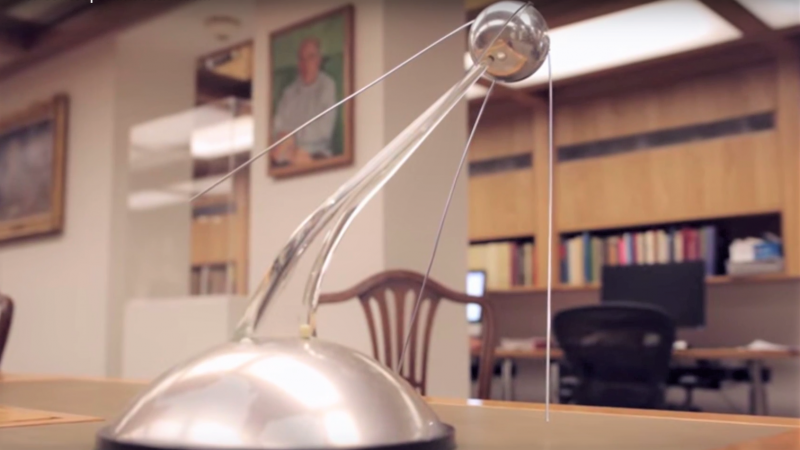As we approach the 60th anniversary of the human race becoming a spacefaring species, Sputnik nostalgia will no doubt be on the rise. And rightly so — even though Sputnik was remarkably primitive compared to today’s satellites, its 1957 launch was an inflection point in history and a huge achievement for humanity.
The Soviets, understandably proud of their accomplishment, created a series of commemorative models of Earth’s first artificial moon as gifts to other countries. How one came into possession of the Royal Society isn’t clear, but [Fran Blanche] found out about it through a circuitous route detailed in the video below, and undertook to reproduce the original electronics from the model that made the distinctive Sputnik beeps.
The Royal Society’s version of the model no longer works, but luckily it came with a schematic of the solid-state circuit used to emulate the original’s vacuum-tube guts. Intent on building the circuit as close to vintage as possible and armed with a bag of germanium transistors from the 60s, [Fran] worked through the schematic, correcting a few issues here and there, and eventually brought the voice of Sputnik back to life.
If you think we’ve covered Sputnik’s rebirth before, you may be thinking about our article on how some hams rebuilt Sputnik’s guts from a recently uncovered Soviet-era schematic. [Fran]’s project just reproduces the sound of Sputnik — no license required!
















Public Service Broadcasting!
Also possibly of particular interest, their song “Spitfire”, which uses audio samples from a 1940s movie about the creation of the Spitfire fighter plane.
It would be nice if they at least went out of the way to use/manufacture vacuum tubes but they didn’t. :/
She reproduced the version that the Royal Society has, which was provided by the Russians, and used transistors. If she wanted to do the original with “tubes”, she could have. This is a nice build and the video, like all of her stuff, is great fun. We need more Fran Lab to cheer us up! :)
Great piece of electronics puzzle solving.
I wonder if the real original sputnik circuit is documented somewhere – from the video this is probably something made to sound somewhat like sputnik not based on the real design.
Actually i found the Schematics – link is a russian PDF.
ftp://ftp.radio.ru/pub/2013/04/55.pdf
Nice video, good that she’s going through the process step by step.
Extra points for the vintage oscilloscope in the photo!
I’ve checked the parameters of the П6Г transistors used in the original model, and it looks like their beta was only guaranteed to be above 32. Interesting! On a side note, the 1Ж29Б tubes probably used in the original Sputnik weren’t that wasteful: the heater only consumed 60 mA at 1.2 V. Also, I remember reading that they were installed without the glass enclosures to cut down on weight, ‘cuz it’s vacuum out there anyway.
Sputnik 1 was pressurized with nitrogen to 1.3 atm, i don’t know if the behavior of the tubes change significantly with this environment
The pressurization of Sputnik 1 probably makes it the first space experiment. It was done to detect if there were micro-meteoroids. It was more than just a beep, it was temperature data for the inside and outside of the craft.
It also allowed cooling of the components the pitch would change if it lost pressure so they’d know what happened before it overheated and died.
Pressurized containers were still used for the electronics of later Soviets/Russian spacecraft designs such as the Lunakhod rovers while US designs tended tended to use heat pipes and cold plates for thermal regulation.
I remember reading somewhere that Sputnik “encoded” internal temperature in its beeps? Could this just be thermal drift due to earth shadow, or was this an intended feature of its design?
I was 12 when Sputnik was launched, but I had a Hallicrafters shortwave radio and I tuned to what I thought was the Sputnik frequency of 20 megacycles (before the adoption of Mhz). Sure enough, there was a “beep – beep – beep. I rushed the whole family in and proudly said: “Behold, the Sputnik”!
Then a voice came in over the static and beeping: “Dominion Observatory Canada The time is seven thirty pm.” Humiliated, I retired to my bedroom for the rest of the night.
Now they need to add the Doppler effect as if it were passing overhead.
Here’s the original: https://www.youtube.com/watch?v=r-bQEiklsK8
It is apparent that the hot science girl have reproduced the tone generator circuit, but there’s more to it. the frequency is clearly modulated to produce 3 distinct tones cycling every second. There could be data overlaid in this. I did read somewhere that temperature data was encoded in the signal also.
The tones you hear are not generated from the satellite but instead were generated as a beat frequency. Sputnik alternately transmitted at about 20 and 40 mhz. The limited telemetry was encoded in the duration of the transitions between the two distinct frequencies and not in some tone.
To be clear, it is the model at the Royal Society that is being reproduced in the video, not the actual satellite. ☺